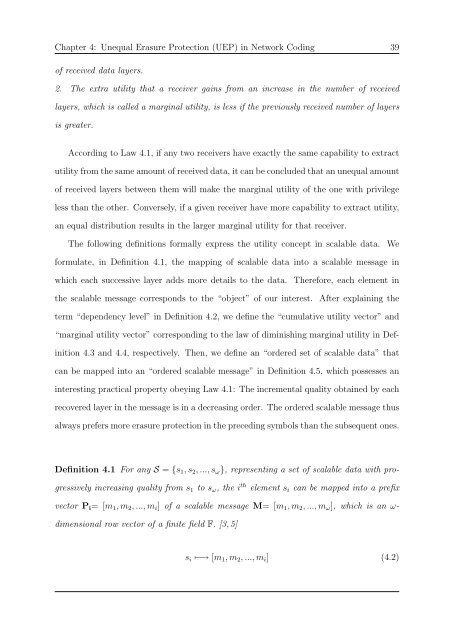Network Coding and Wireless Physical-layer ... - Jacobs University
Network Coding and Wireless Physical-layer ... - Jacobs University
Network Coding and Wireless Physical-layer ... - Jacobs University
Create successful ePaper yourself
Turn your PDF publications into a flip-book with our unique Google optimized e-Paper software.
Chapter 4: Unequal Erasure Protection (UEP) in <strong>Network</strong> <strong>Coding</strong> 39<br />
of received data <strong>layer</strong>s.<br />
2. The extra utility that a receiver gains from an increase in the number of received<br />
<strong>layer</strong>s, which is called a marginal utility, is less if the previously received number of <strong>layer</strong>s<br />
is greater.<br />
According to Law 4.1, if any two receivers have exactly the same capability to extract<br />
utility from the same amount of received data, it can be concluded that an unequal amount<br />
of received <strong>layer</strong>s between them will make the marginal utility of the one with privilege<br />
less than the other. Conversely, if a given receiver have more capability to extract utility,<br />
an equal distribution results in the larger marginal utility for that receiver.<br />
The following definitions formally express the utility concept in scalable data. We<br />
formulate, in Definition 4.1, the mapping of scalable data into a scalable message in<br />
which each successive <strong>layer</strong> adds more details to the data. Therefore, each element in<br />
the scalable message corresponds to the “object” of our interest. After explaining the<br />
term “dependency level” in Definition 4.2, we define the “cumulative utility vector” <strong>and</strong><br />
“marginal utility vector” corresponding to the law of diminishing marginal utility in Definition<br />
4.3 <strong>and</strong> 4.4, respectively. Then, we define an “ordered set of scalable data” that<br />
can be mapped into an “ordered scalable message” in Definition 4.5, which possesses an<br />
interesting practical property obeying Law 4.1: The incremental quality obtained by each<br />
recovered <strong>layer</strong> in the message is in a decreasing order. The ordered scalable message thus<br />
always prefers more erasure protection in the preceding symbols than the subsequent ones.<br />
Definition 4.1 For any S = {s 1 , s 2 , ..., s ω }, representing a set of scalable data with progressively<br />
increasing quality from s 1 to s ω , the i th element s i can be mapped into a prefix<br />
vector P i = [m 1 , m 2 , ..., m i ] of a scalable message M= [m 1 , m 2 , ..., m ω ], which is an ω-<br />
dimensional row vector of a finite field F. [3, 5]<br />
s i ↦−→ [m 1 , m 2 , ..., m i ] (4.2)

















